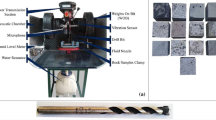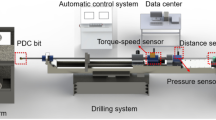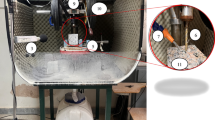Abstract
Measurement while drilling (MWD) is one of the most important and useful tasks in mining operations. Access to a method for the accurate measurement of drill and rock-related operating parameters can greatly reduce the cost of drilling operations. Abrasivity is an important rock property with a direct impact on the wear rate and lifetime of drilling equipment as well as the rate of penetration. While many methods and standards have been developed for the measurement of rock abrasivity, these methods are often costly and time-consuming and require complex preparation. This study investigates the possibility of estimating the rock abrasivity by processing the acoustic and vibration signals generated while drilling. For this purpose, 13 samples of igneous rocks, which are classified as hard rocks, are used for drilling tests. Before the tests, the Schimazek abrasivity factor of the samples was obtained by measuring their strength and texture properties (from petrographic thin sections). Acoustic and vibration signals were analyzed in time, frequency and time–frequency domains, and a series of parameters related to the resulting spectra were extracted. After obtaining the acoustic and vibration parameters for drilling, the relationship between them and the abrasivity of the rock was investigated. Using a combination of PCA and MLR, the first seven principal independent components of input parameters were obtained. They were used to formulate an equation to predict the abrasivity of hard rocks with a correlation coefficient (R2) of 0.9574. The accuracy of the model in terms of RMSE and MAE are 1.87 and 1.49, respectively. The results of this study show the possibility of estimation of rock properties by processing the signals generated during the rock drilling operation. This approach can be used in real-scale operations in the industry simply by installing acoustic and vibration sensors on the drilling rig for a fast, accurate, and non-destructive determination of the abrasivity of rocks and the related operating parameters without the necessity to stop the drilling process for sampling and in laboratory measurements.
Highlights
-
Rock abrasivity is one of the most important geomechanical properties of rocks which has a direct impact on the choice of operating parameters and reducing the time and costs of projects.
-
One of the most widely used indicators of the abrasivity of rocks is the Schimazek abrasivity factor.
-
In recent years, acoustic waves have been increasingly used for the prediction of material properties and in monitoring and detection.
-
The acoustic and vibration waves generated during drilling and the laboratory environment sound pressure level recorded during the drilling were processed by Fast Fourier Transform (FFT) and Short Time Fourier Transform (STFT).
-
Abrasivity of a rock being drilled can be estimated accurately and almost in real-time by processing the signals generated during the drilling operation.


















Similar content being viewed by others
References
Abdi H, Williams L (2010) Principal component analysis. Wiley Interdiscip Rev Comput Stat 2:433–459
Aggelis DG, Shiotani T, Momoki S, Hirama A (2009) Acoustic emission and ultrasound for damage characterization of concrete elements. ACI Mater J 106:509
Boness R, McBride S (1991) Adhesive and abrasive wear studies using acoustic emission techniques. Wear 149:41–53. https://doi.org/10.1016/0043-1648(91)90363-Y
Çamdevýren H, Demýr N, Kanik A, Keskýn S (2005) Use of principal component scores in multiple linear regression models for prediction of Chlorophyll-a in reservoirs. Ecol Model 181:581–589. https://doi.org/10.1016/j.ecolmodel.2004.06.043
Filipussi DA, Guzmán CA, Xargay HD, Hucailuk C, Torres DN (2015) Study of acoustic emission in a compression test of andesite rock. Proc Mater Sci 9:292–297. https://doi.org/10.1016/j.mspro.2015.04.037
Flegner P, Kačur J, Durdán M, Leššo I, Laciak M (2014) Measurement and processing of vibro-acoustic signal from the process of rock disintegration by rotary drilling. Measurement 56:178–193. https://doi.org/10.1016/j.measurement.2014.06.025
Gómez MP, Hey AM, Ruzzante JE, D’Attellis CE (2010) Tool wear evaluation in drilling by acoustic emission. Phys Proc 3:819–825. https://doi.org/10.1016/j.phpro.2010.01.105
Griffin D, Lim J (1984) Signal estimation from modified short-time Fourier transform. IEEE Trans Acoust Speech Signal Process 32:236–243. https://doi.org/10.1109/TASSP.1984.1164317
Hopwood T, McGogney C (1987) Acoustic emission applications in civil engineering. Nondestruct Test Handb 5:325–345
Jurado F, Saenz JR (2002) Comparison between discrete STFT and wavelets for the analysis of power quality events. Electric Power Syst Res 62:183–190. https://doi.org/10.1016/S0378-7796(02)00035-4
Kahraman S, Delibalta M, Comakli R (2013) Noise level measurement test to predict the abrasion resistance of rock aggregates. Fluct Noise Lett 12:1350021. https://doi.org/10.1142/S0219477513500211
Khoshouei M, Bagherpour R (2019) Application of Acoustic Emission (AE) in mining and earth sciences: a review. RGN Zbornik. https://doi.org/10.17794/rgn.2019.4.3
Khoshouei M, Bagherpour R (2020) Predicting the geomechanical properties of hard rocks using analysis of the acoustic and vibration signals during the drilling operation. Geotech Geol Eng. https://doi.org/10.1007/s10706-020-01611-z
Khoshouei M, Bagherpour R, Jalalian MH (2021) Rock type identification using analysis of the acoustic signal frequency contents propagated while drilling operation. Geotech Geol Eng. https://doi.org/10.1007/s10706-021-01957-y
Krúpa V, Kruľáková M, Lazarová E, Labaš M, Feriančiková K, Ivaničová L (2018) Measurement, modeling and prediction of penetration depth in rotary drilling of rocks. Measurement 117:165–175. https://doi.org/10.1016/j.measurement.2017.12.007
Kumar BR, Vardhan H, Govindaraj M (2011a) Prediction of uniaxial compressive strength, tensile strength and porosity of sedimentary rocks using sound level produced during rotary drilling. Rock Mech Rock Eng 44:613–620. https://doi.org/10.1007/s00603-011-0160-7
Kumar BR, Vardhan H, Govindaraj M (2011b) Sound level produced during rock drilling vis-à-vis rock properties. Eng Geol 123:333–337. https://doi.org/10.1016/j.enggeo.2011.09.009
Kumar BR, Vardhan H, Govindaraj M, Saraswathi SP (2013) Artificial neural network model for prediction of rock properties from sound level produced during drilling. Geomech Geoeng 8:53–61. https://doi.org/10.1080/17486025.2012.661469
Pearson K (1901) LIII. On lines and planes of closest fit to systems of points in space. Lond Edinb Dublin Philos Mag J Sci 2:559–572. https://doi.org/10.1080/14786440109462720
Přikryl R, Lokajíček T, Li C, Rudajev V (2003) Acoustic emission characteristics and failure of uniaxially stressed granitic rocks: the effect of rock fabric. Rock Mech Rock Eng 36:255–270. https://doi.org/10.1007/s00603-003-0051-7
Qin M, Wang K, Pan K, Sun T, Liu Z (2018) Analysis of signal characteristics from rock drilling based on vibration and acoustic sensor approaches. Appl Acoust 140:275–282. https://doi.org/10.1016/j.apacoust.2018.06.003
Rai A, Upadhyay S (2016) A review on signal processing techniques utilized in the fault diagnosis of rolling element bearings. Tribol Int 96:289–306. https://doi.org/10.1016/j.triboint.2015.12.037
Rivero Ad, de Lacalle LL, Penalva ML (2008) Tool wear detection in dry high-speed milling based upon the analysis of machine internal signals. Mechatronics 18:627–633. https://doi.org/10.1016/j.mechatronics.2008.06.008
Schimazek J, Knatz H (1970) The influence of rock composition on cutting velocity and chisel wear of tunneling machines. J Glückauf 106:274–278
Selmer-Olsen R, Lien R (1960) Bergartens Borbarhet Og Sprengbarhet. Teknisk Ukeblad 34:3–11
Sievers H (1950) Die bestimmung des bohrwiderstandes von gesteinen. J Glückauf 86:776–784
Singh R, Umrao RK, Ahmad M, Ansari M, Sharma L, Singh TJM (2017) Prediction of geomechanical parameters using soft computing and multiple regression approach. Measurements 99:108–119. https://doi.org/10.1016/j.measurement.2016.12.023
Stolarski T (2000) Tribology in machine design. Butterworth-Heinemann, Oxford
Tarkoy PJ, Hendron A (1975) Rock hardness index properties and geotechnical parameters for predicting tunnel boring machine performance. University of Illinois, Urbana-Champaign
Thuro K (1997) Drillability prediction: geological influences in hard rock drill and blast tunnelling. Geol Rundsch 86:426–438. https://doi.org/10.1007/s005310050151
Thuro K, Singer J, Käsling H, Bauer M (2006) Soil abrasivity assessment using the LCPC testing device. Felsbau 24:37–45
Thuro K, Singer J, Kasling H, Bauer M (2007) Determining abrasivity with the LCPC test. 1st Canada-US Rock Mechanics Symposium. American Rock Mechanics Association
Vardhan H, Adhikari G, Raj MG (2009) Estimating rock properties using sound levels produced during drilling. Int J Rock Mech Min Sci 46:604–612. https://doi.org/10.1016/j.ijrmms.2008.07.011
Verhoef PN (2017) Wear of rock cutting tools: implications for the site investigation of rock dredging projects. Routledge, London
Verwaal W, Mulder A (1993) Estimating rock strength with the Equotip hardness tester. In: International journal of rock mechanics and mining sciences and geomechanics abstracts. Elsevier Science, Amsterdam. pp 659–62
Wang K, Liu G, Wu J, Liu Z, Yi L, Zhang J, Du J (2017) Acoustic sensor approaches for sand detection in sand–water two-phase flows. Powder Technol 320:739–747. https://doi.org/10.1016/j.powtec.2017.07.025
Wold S, Esbensen K, Geladi P (1987) Principal component analysis. Chemom Intell Lab Syst 2:37–52. https://doi.org/10.1016/0169-7439(87)80084-9
Xiao Y, Hurich C, Molgaard J, Butt SD (2018) Investigation of active vibration drilling using acoustic emission and cutting size analysis. J Rock Mech Geotech Eng 10:390–401. https://doi.org/10.1016/j.jrmge.2017.10.002
Yari M, Bagherpour R (2018a) Implementing acoustic frequency analysis for development the novel model of determining geomechanical features of igneous rocks using rotary drilling device. Geotech Geol Eng 36:1805–1816. https://doi.org/10.1007/s10706-017-0433-3
Yari M, Bagherpour R (2018b) Investigating an innovative model for dimensional sedimentary rock characterization using acoustic frequency analysis during drilling. Rudarsko-Geolosko-Naftni Zbornik 33:17–25
Yari M, Bagherpour R, Khoshouei M (2019) Developing a novel model for predicting geomechanical features of carbonate rocks based on acoustic frequency processing during drilling. Bull Eng Geol Environ 78:1747–1759. https://doi.org/10.1007/s10064-017-1197-y
Yılmaz NG (2011) Abrasivity assessment of granitic building stones in relation to diamond tool wear rate using mineralogy-based rock hardness indexes. Rock Mech Rock Eng 44:725. https://doi.org/10.1007/s00603-011-0166-1
Zum Gahr K-H (1987) Microstructure and wear of materials. Elsevier, Amsterdam
Author information
Authors and Affiliations
Contributions
RB and MK performed the design, implementation of the research and contributed to the writing of the manuscript, HS and MHJ contributed to the analysis of the results and the writing of the manuscript. MK and HS coded in Matlab environment.
Corresponding author
Additional information
Publisher's Note
Springer Nature remains neutral with regard to jurisdictional claims in published maps and institutional affiliations.
Rights and permissions
About this article
Cite this article
Khoshouei, M., Bagherpour, R., Sadeghisorkhani, H. et al. A New Look at Hard Rock Abrasivity Evaluation Using Acoustic Emission Technique (AET). Rock Mech Rock Eng 55, 2425–2443 (2022). https://doi.org/10.1007/s00603-022-02787-x
Received:
Accepted:
Published:
Issue Date:
DOI: https://doi.org/10.1007/s00603-022-02787-x




